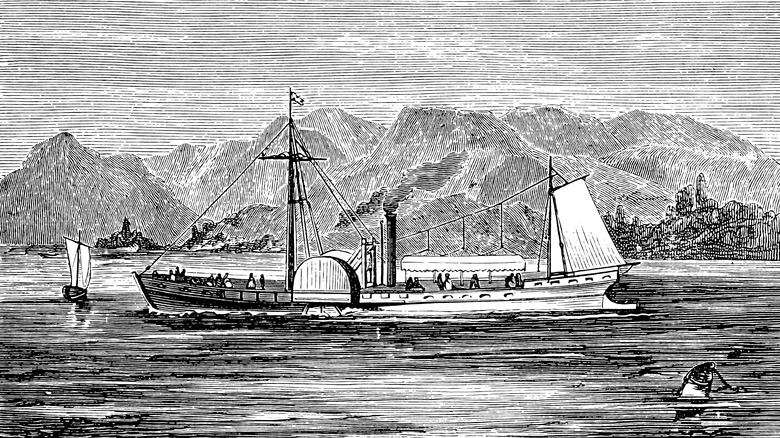What It Means When You See SS On A Ship
"Hoist the mainsail and scuttle the jib! Don't let it luff! Yank the halyard starboard and clamp the boom vang! Keep the tack to the wind lest we ride this storm a-hull!" For all of the one to two percent of people who understand what any of that means: Congratulations. For everyone else, those few sentences ought to convey precisely how little we moderns understand old nautical terms, sailing operations, parts of ships, etc. This includes ship prefixes, which people might recognize from "Star Trek" more than real life. USS Enterprise, anyone? But what does the "USS" mean, anyway? Or HMS, RMS, TSS, or anything else. What about plain old SS? That one dates back to 19th-century propulsion methods: steam.
The short of it is: SS means "steamship," aka, a mechanical ship that has no sails and moves forward using a steam engine, instead. You'll recognize this type of ship from the big smoke stacks on top, like those on the legendary Titanic that sunk to the bottom of the Atlantic Ocean in 1912. That's RMS Titanic, by the way: Royal Mail Steamer. That's because, in addition to 2,240 passengers, the Titanic was also carrying between six and nine million — yes, million — individual letters on its voyage. Hence mail steamer.
"SS," however, is the most generic prefix for a steam-powered vessel. It predates other, more specific designations. The 19th to early 20th centuries saw ships use either traditional sails or cutting-edge steam, and it was important to recognize what types of ships were crisscrossing Earth's waters.
Ships in the age of steam
Like many scientific discoveries, the development of steam engines built on centuries of prior observation and inquiry. As far back as the first century C.E., the Greek mathematician and engineer Hero built a steam-powered contraption that spun around when water got heated and vapor passed through a tube. Fundamentally, this is no different from how steam engines introduce pressure through a valve and into a cylinder and cause pistons to pump up and down, which makes wheels on a steamboat spin, and so forth.
While engineer Thomas Savery gets credit for patenting the first steam pump in 1698, it's American engineer Robert Fulton who gets credit for building and sailing the first actual steamship in 1807, the Clermont. This was an actual, functioning passenger ship, and not just a prototype to poke across a lake or something. And note the name of the ship: just "Clermont," no SS or any prefix of any other kind. By 1836, however — less than 30 years later — we get the SS Great Western, the first cross-Atlantic steamship. This was a steam-powered wooden ship, mind you, and also a passenger ship, with paddle wheels that push water to push the ship forward.
That's an awful lot of progress in 30 years, and helps explain why ships started needing designations like SS. Steamboats were still very, very new at the time, very slow (five to eight miles per hour), and not too safe. But, they exploded in quantity. So many were made that by the mid-1800s, over 289 steamboats had sunk in the Mississippi River alone.
Changes in meaning over time
It's a bit hard to track the development of plain and simple "SS" to the absolute glut of prefixes we've got nowadays. But, we can safely say that it happened over time in response to changing needs in global sailing, better methods of tracking both cargo and passenger ships, and in response to different types of ships being built.
The current-day prefix list is something of a mess of dated, vestigial designations mixed with newer prefixes. "TS" used to stand for "turbine ship," a defunct type of ship, and now stands for "training ship." "GTS" builds on TS and means, "gas turbine ship." "USS," meanwhile — yes, like the Enterprise — contains "SS" but doesn't mean steamship. It means "United States Ship." "TSS" also contains "SS," which in this case does mean "steamship." Specifically, it means "twin-screw steamship." Then there's MS (motor ship), HMS (His/Her Majesty's Ship), JS (Japanese Ship), NS (nuclear ship), CS (cable ship), and on and on and on. It all makes the meaning of SS seem much clearer and more quaint in comparison.
Finally and to add to the confusion, the Navy has its own set of abbreviations and prefixes that sometimes overlap with general nautical prefixes, but have different meanings. Per Naval History and Heritage Command, we're talking a monstrous list of hundreds and hundreds of terms. One of them we know well at this point: SS. But to the navy, who also pilot tubes of metal underwater, SS can also mean "submarine."


